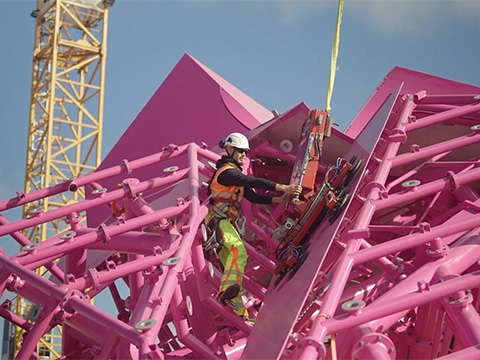
Posted to News on 8th Jul 2025, 13:30
Towering piece of public art that relies on Nord-Lock washers
High above ground, the bold steel structure of the bLINK art project is secured with Nord-Lock wedge locking washers to ensure safe bolted connections in this demanding installation.

A gigantic pink structure looms above the Olskroken traffic junction in the Swedish city of Gothenburg. About the size of a small aircraft hangar or typical convenience store, it stands almost where a building's third floor would be, atop steel legs - also pink- jutting up from a new railway bridge that crosses over the E6 highway.
The sculpture looks something like a boulder, yet with harder geometric lines casting shadows that turn the metal skin magenta in places. But it's still all the same uniform hue of pink, which radiates out onto the grey concrete of the bridge and the adjoining asphalt ground, as if the colour shines from the overhanging sculpture.
bLINK is unlike any previous piece of public art in Sweden. It's a permanent installation intended to last for decades, so it had to be built to withstand the test of time but also endure the unique conditions of its location. And Nord-Lock Washers were a key part in making that possible.
Conceived by German artist Katharina Grosse, bLINK is the first completed piece from the Kronotopia art programme - which commissions original artworks for Vastlanken (the West Link Project), a major railway infrastructure initiative in Gothenburg. Kronotopia involves artists early in the architectural process to create more unique public spaces and provide an overall artistic influence on the new railway.
Grosse explains bLINK developed out of an interest in creating something visible from different parts of the city, but that also condensed into one place - such as an ordinary location people pass by every day. "Where your attention could be woken up a little, where you at least expect it," says Grosse.
"So this idea of something flashing up in the corner of your eye and you blink and you go, it's passed already, but there was something a visual sensation can happen to you, and you remember it at the end of the day, and you have maybe seen it only for a second."
Withstanding vibrations, corrosion and more
Grosse's final design features a steel substructure stretching almost 12 metres high, with a main section roughly 225 square metres [8] and covered with 10-metre-wide plates of 10-millimetre-thick aluminium. All together, it weighs a total of 35 tonnes.
According to Bernhard Hahner, Managing Director of Hahner Technik, the German firm contracted to fabricate and help install bLINK, the job presented numerous unique challenges - the most obvious being that the installation would sit over a railway bridge and a busy highway.
"With this construction, we definitely had what you can call a 'vibration problem'," says Hahner, referring to the constant shaking from the dynamic loads of cars and trains moving underneath the sculpture that could vibrate the structure enough to loosen the bolted connections holding it together.
bLINK is also outside year-round, exposed to the elements - like damp and briny coastal winds from the nearby North Sea that can cause corrosion and rust, as well as the rapidly fluctuating temperatures of Gothenburg's weather that can cause metal to quickly expand and contract.
What's more, as Hahner points out, any bolting or fastening system that could handle those challenges would also have to seamlessly integrate into bLINK's design and not stand out in any way. "So to find a solution for everything, it's technically demanding," he admits. "It was really a plug-and-play situation."
Hahner ultimately turned to Nord-Lock for the bolted connections needed to make bLINK a reality. Hailing from the village of Mattmar in northern Sweden, the brand dates back to 1982 - when it introduced the ground-breaking wedge-locking technology for securing bolted joints.
Nord-Lock wedge-locking washers are documented to stay secure through severe vibration and have been used in billions of projects around the world and across every industry, earning a reputation for uncompromising quality and reliability when safety is of the utmost importance.
"Nord-Lock also turned out to be the easiest, most time-efficient solution for assembly," says Hahner. "We didn't have to redesign or rethink any parts of the original design. So, it was really a plug-and-play situation, which fortunately did not make an already complex construction even more so."
According to Frank Gotz, Business Development Manager for Construction at the Nord-Lock Group, the model of stainless-steel washers selected for the project is ideal for withstanding extreme conditions and going unnoticed. "The wedge-locking washer used by Hahner for the bLINK project is one of the best alternatives to date for ensuring that the bolted connections do not stand out negatively due to rust buildup," he explains.
Construction began not long after Nord-Lock was selected for the bLINK project. Installation took place in the fall of 2024, and the completed piece was officially inaugurated in May of 2025. The entire Vastlanken railway project is expected to be fully finished by 2030. And bLINK - with the help of Nord-Lock washers - will still be standing then and for many years to come afterwards.





